HRM101: Analysis of Wipro Project Manager and Performance Appraisal
VerifiedAdded on 2022/04/26
|15
|3756
|51
Report
AI Summary
This report, submitted by a student for the HRM101 course, provides a comprehensive overview of Wipro Limited, an IT, consulting, and business process services company. The assignment begins with an introduction to Wipro, its history, leadership, vision, and awards. The first part of the report focuses on the role of a project manager in IT, detailing their responsibilities including project planning, team leadership, progress monitoring, problem-solving, budget management, stakeholder satisfaction, and project performance evaluation. The second part delves into Wipro's performance appraisal methods, highlighting the shift from traditional systems to the 360-degree feedback approach. This method involves self-appraisals, managerial reviews, peer reviews, subordinate appraisals, and customer reviews, providing a multi-dimensional evaluation of employee performance. The report also discusses the advantages of the 360-degree feedback system and its suitability for the private sector.
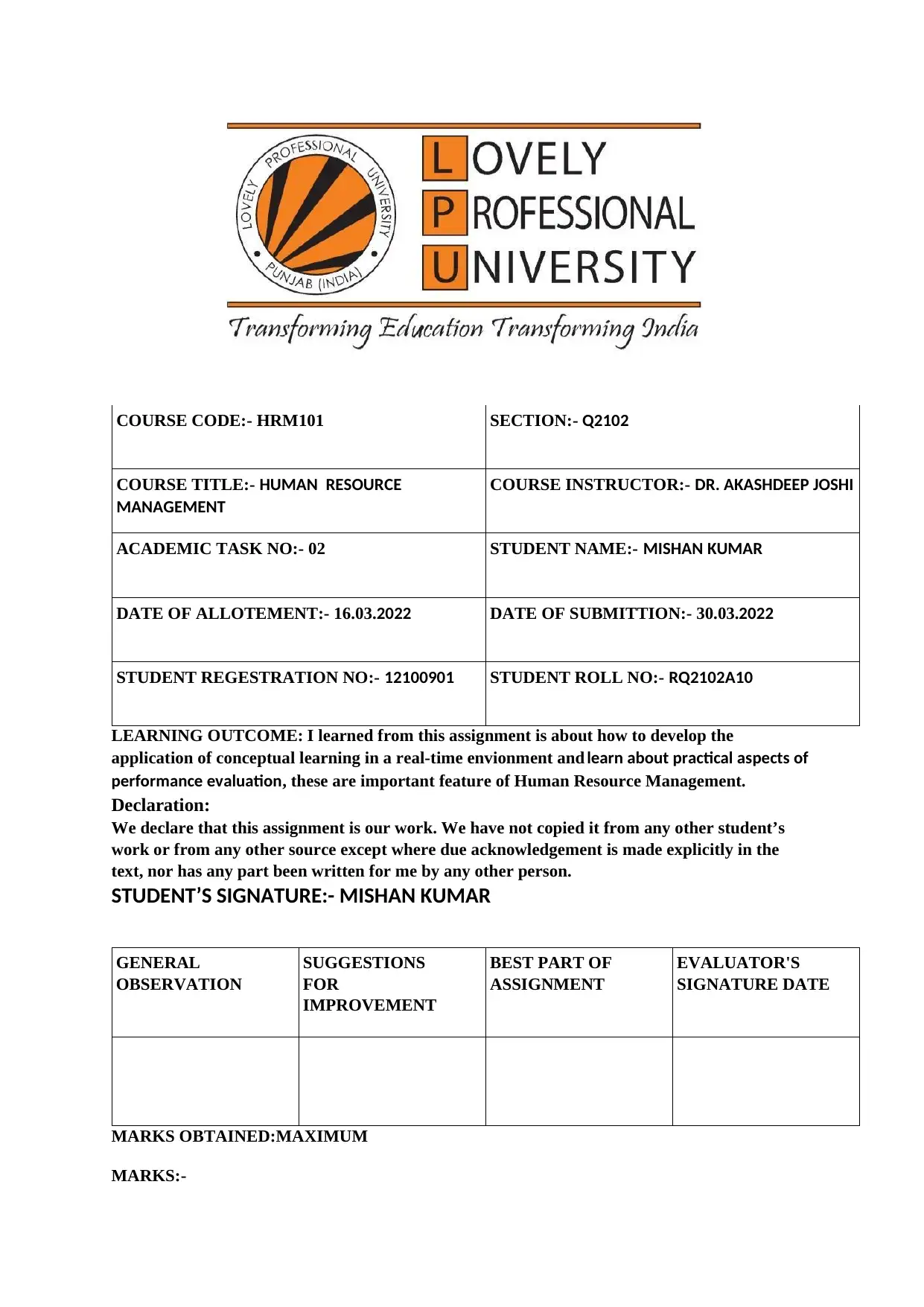
COURSE CODE:- HRM101 SECTION:- Q2102
COURSE TITLE:- HUMAN RESOURCE
MANAGEMENT
COURSE INSTRUCTOR:- DR. AKASHDEEP JOSHI
ACADEMIC TASK NO:- 02 STUDENT NAME:- MISHAN KUMAR
DATE OF ALLOTEMENT:- 16.03.2022 DATE OF SUBMITTION:- 30.03.2022
STUDENT REGESTRATION NO:- 12100901 STUDENT ROLL NO:- RQ2102A10
LEARNING OUTCOME: I learned from this assignment is about how to develop the
application of conceptual learning in a real-time envionment and learn about practical aspects of
performance evaluation, these are important feature of Human Resource Management.
Declaration:
We declare that this assignment is our work. We have not copied it from any other student’s
work or from any other source except where due acknowledgement is made explicitly in the
text, nor has any part been written for me by any other person.
STUDENT’S SIGNATURE:- MISHAN KUMAR
GENERAL
OBSERVATION
SUGGESTIONS
FOR
IMPROVEMENT
BEST PART OF
ASSIGNMENT
EVALUATOR'S
SIGNATURE DATE
MARKS OBTAINED:MAXIMUM
MARKS:-
COURSE TITLE:- HUMAN RESOURCE
MANAGEMENT
COURSE INSTRUCTOR:- DR. AKASHDEEP JOSHI
ACADEMIC TASK NO:- 02 STUDENT NAME:- MISHAN KUMAR
DATE OF ALLOTEMENT:- 16.03.2022 DATE OF SUBMITTION:- 30.03.2022
STUDENT REGESTRATION NO:- 12100901 STUDENT ROLL NO:- RQ2102A10
LEARNING OUTCOME: I learned from this assignment is about how to develop the
application of conceptual learning in a real-time envionment and learn about practical aspects of
performance evaluation, these are important feature of Human Resource Management.
Declaration:
We declare that this assignment is our work. We have not copied it from any other student’s
work or from any other source except where due acknowledgement is made explicitly in the
text, nor has any part been written for me by any other person.
STUDENT’S SIGNATURE:- MISHAN KUMAR
GENERAL
OBSERVATION
SUGGESTIONS
FOR
IMPROVEMENT
BEST PART OF
ASSIGNMENT
EVALUATOR'S
SIGNATURE DATE
MARKS OBTAINED:MAXIMUM
MARKS:-
Paraphrase This Document
Need a fresh take? Get an instant paraphrase of this document with our AI Paraphraser
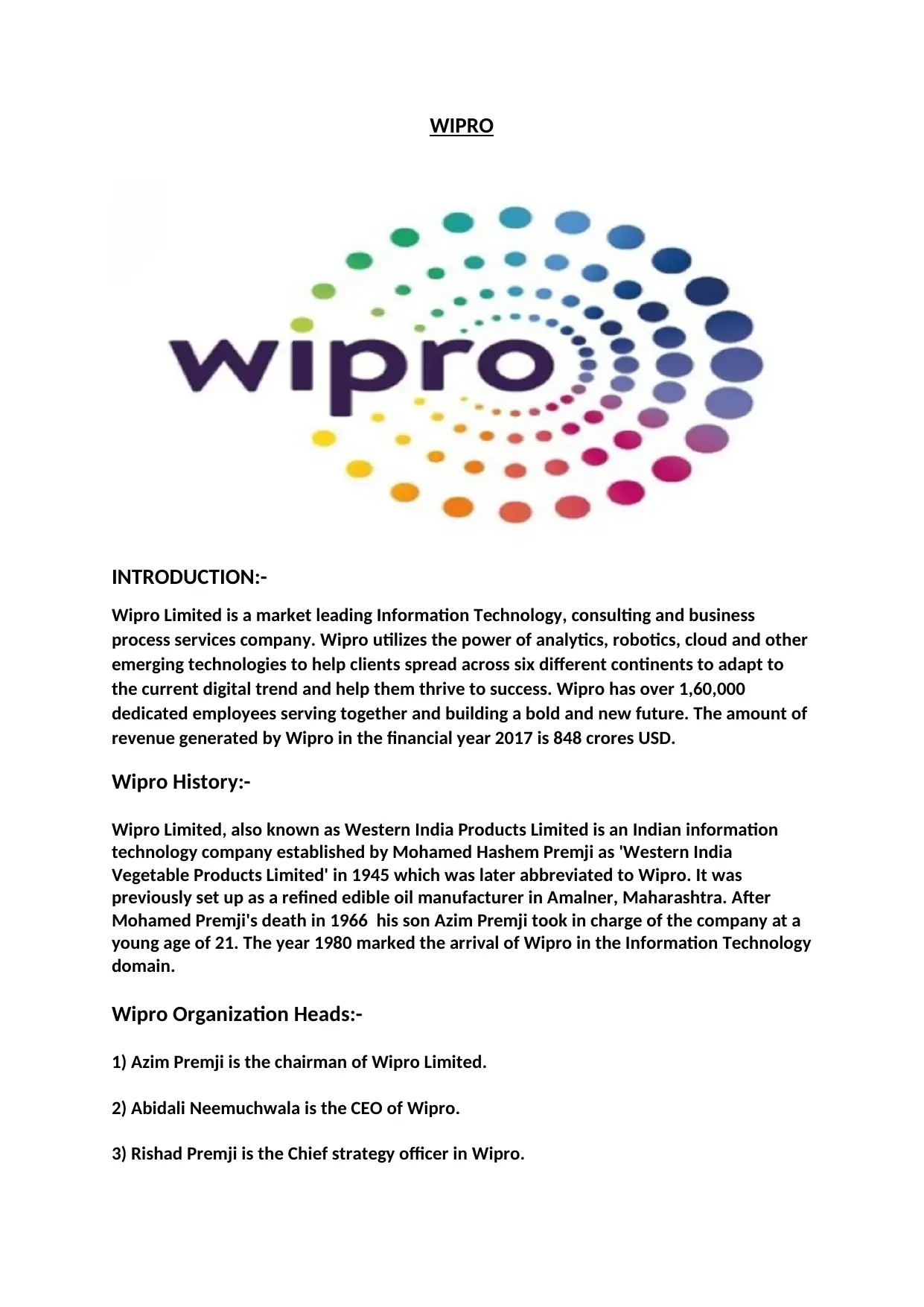
WIPRO
INTRODUCTION:-
Wipro Limited is a market leading Information Technology, consulting and business
process services company. Wipro utilizes the power of analytics, robotics, cloud and other
emerging technologies to help clients spread across six different continents to adapt to
the current digital trend and help them thrive to success. Wipro has over 1,60,000
dedicated employees serving together and building a bold and new future. The amount of
revenue generated by Wipro in the financial year 2017 is 848 crores USD.
Wipro History:-
Wipro Limited, also known as Western India Products Limited is an Indian information
technology company established by Mohamed Hashem Premji as 'Western India
Vegetable Products Limited' in 1945 which was later abbreviated to Wipro. It was
previously set up as a refined edible oil manufacturer in Amalner, Maharashtra. After
Mohamed Premji's death in 1966 his son Azim Premji took in charge of the company at a
young age of 21. The year 1980 marked the arrival of Wipro in the Information Technology
domain.
Wipro Organization Heads:-
1) Azim Premji is the chairman of Wipro Limited.
2) Abidali Neemuchwala is the CEO of Wipro.
3) Rishad Premji is the Chief strategy officer in Wipro.
INTRODUCTION:-
Wipro Limited is a market leading Information Technology, consulting and business
process services company. Wipro utilizes the power of analytics, robotics, cloud and other
emerging technologies to help clients spread across six different continents to adapt to
the current digital trend and help them thrive to success. Wipro has over 1,60,000
dedicated employees serving together and building a bold and new future. The amount of
revenue generated by Wipro in the financial year 2017 is 848 crores USD.
Wipro History:-
Wipro Limited, also known as Western India Products Limited is an Indian information
technology company established by Mohamed Hashem Premji as 'Western India
Vegetable Products Limited' in 1945 which was later abbreviated to Wipro. It was
previously set up as a refined edible oil manufacturer in Amalner, Maharashtra. After
Mohamed Premji's death in 1966 his son Azim Premji took in charge of the company at a
young age of 21. The year 1980 marked the arrival of Wipro in the Information Technology
domain.
Wipro Organization Heads:-
1) Azim Premji is the chairman of Wipro Limited.
2) Abidali Neemuchwala is the CEO of Wipro.
3) Rishad Premji is the Chief strategy officer in Wipro.
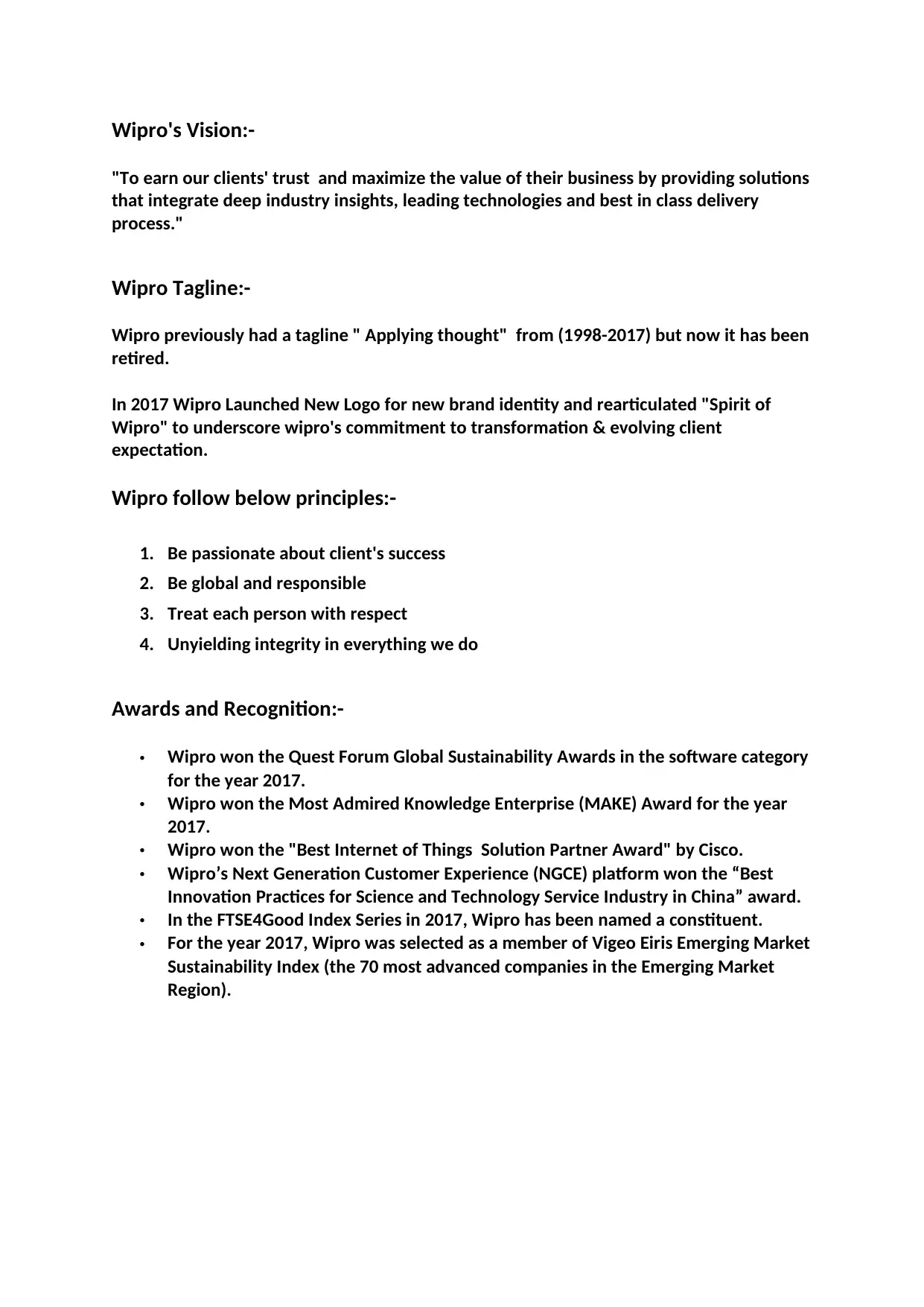
Wipro's Vision:-
"To earn our clients' trust and maximize the value of their business by providing solutions
that integrate deep industry insights, leading technologies and best in class delivery
process."
Wipro Tagline:-
Wipro previously had a tagline " Applying thought" from (1998-2017) but now it has been
retired.
In 2017 Wipro Launched New Logo for new brand identity and rearticulated "Spirit of
Wipro" to underscore wipro's commitment to transformation & evolving client
expectation.
Wipro follow below principles:-
1. Be passionate about client's success
2. Be global and responsible
3. Treat each person with respect
4. Unyielding integrity in everything we do
Awards and Recognition:-
• Wipro won the Quest Forum Global Sustainability Awards in the software category
for the year 2017.
• Wipro won the Most Admired Knowledge Enterprise (MAKE) Award for the year
2017.
• Wipro won the "Best Internet of Things Solution Partner Award" by Cisco.
• Wipro’s Next Generation Customer Experience (NGCE) platform won the “Best
Innovation Practices for Science and Technology Service Industry in China” award.
• In the FTSE4Good Index Series in 2017, Wipro has been named a constituent.
• For the year 2017, Wipro was selected as a member of Vigeo Eiris Emerging Market
Sustainability Index (the 70 most advanced companies in the Emerging Market
Region).
"To earn our clients' trust and maximize the value of their business by providing solutions
that integrate deep industry insights, leading technologies and best in class delivery
process."
Wipro Tagline:-
Wipro previously had a tagline " Applying thought" from (1998-2017) but now it has been
retired.
In 2017 Wipro Launched New Logo for new brand identity and rearticulated "Spirit of
Wipro" to underscore wipro's commitment to transformation & evolving client
expectation.
Wipro follow below principles:-
1. Be passionate about client's success
2. Be global and responsible
3. Treat each person with respect
4. Unyielding integrity in everything we do
Awards and Recognition:-
• Wipro won the Quest Forum Global Sustainability Awards in the software category
for the year 2017.
• Wipro won the Most Admired Knowledge Enterprise (MAKE) Award for the year
2017.
• Wipro won the "Best Internet of Things Solution Partner Award" by Cisco.
• Wipro’s Next Generation Customer Experience (NGCE) platform won the “Best
Innovation Practices for Science and Technology Service Industry in China” award.
• In the FTSE4Good Index Series in 2017, Wipro has been named a constituent.
• For the year 2017, Wipro was selected as a member of Vigeo Eiris Emerging Market
Sustainability Index (the 70 most advanced companies in the Emerging Market
Region).
⊘ This is a preview!⊘
Do you want full access?
Subscribe today to unlock all pages.

Trusted by 1+ million students worldwide
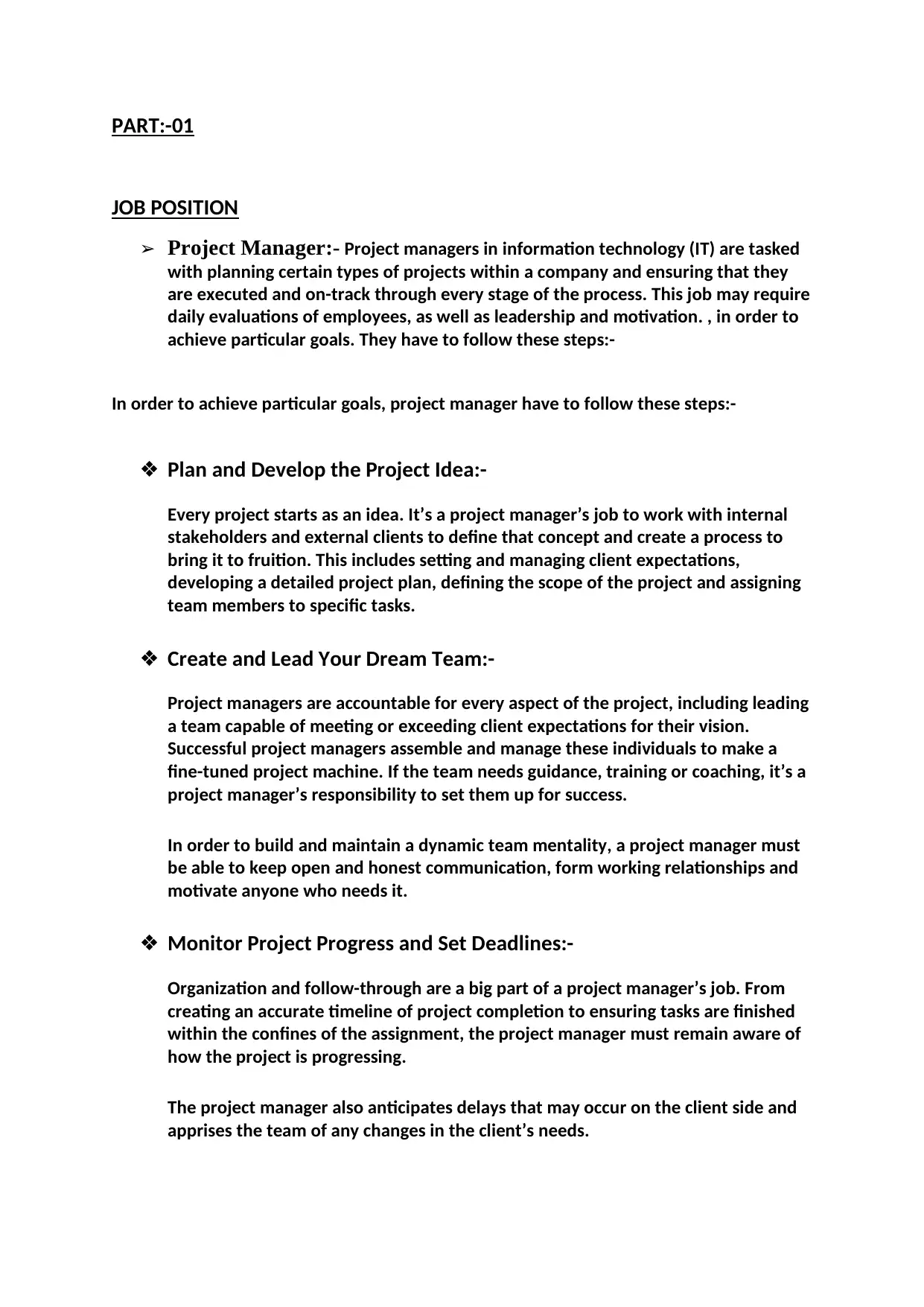
PART:-01
JOB POSITION
➢ Project Manager:- Project managers in information technology (IT) are tasked
with planning certain types of projects within a company and ensuring that they
are executed and on-track through every stage of the process. This job may require
daily evaluations of employees, as well as leadership and motivation. , in order to
achieve particular goals. They have to follow these steps:-
In order to achieve particular goals, project manager have to follow these steps:-
❖ Plan and Develop the Project Idea:-
Every project starts as an idea. It’s a project manager’s job to work with internal
stakeholders and external clients to define that concept and create a process to
bring it to fruition. This includes setting and managing client expectations,
developing a detailed project plan, defining the scope of the project and assigning
team members to specific tasks.
❖ Create and Lead Your Dream Team:-
Project managers are accountable for every aspect of the project, including leading
a team capable of meeting or exceeding client expectations for their vision.
Successful project managers assemble and manage these individuals to make a
fine-tuned project machine. If the team needs guidance, training or coaching, it’s a
project manager’s responsibility to set them up for success.
In order to build and maintain a dynamic team mentality, a project manager must
be able to keep open and honest communication, form working relationships and
motivate anyone who needs it.
❖ Monitor Project Progress and Set Deadlines:-
Organization and follow-through are a big part of a project manager’s job. From
creating an accurate timeline of project completion to ensuring tasks are finished
within the confines of the assignment, the project manager must remain aware of
how the project is progressing.
The project manager also anticipates delays that may occur on the client side and
apprises the team of any changes in the client’s needs.
JOB POSITION
➢ Project Manager:- Project managers in information technology (IT) are tasked
with planning certain types of projects within a company and ensuring that they
are executed and on-track through every stage of the process. This job may require
daily evaluations of employees, as well as leadership and motivation. , in order to
achieve particular goals. They have to follow these steps:-
In order to achieve particular goals, project manager have to follow these steps:-
❖ Plan and Develop the Project Idea:-
Every project starts as an idea. It’s a project manager’s job to work with internal
stakeholders and external clients to define that concept and create a process to
bring it to fruition. This includes setting and managing client expectations,
developing a detailed project plan, defining the scope of the project and assigning
team members to specific tasks.
❖ Create and Lead Your Dream Team:-
Project managers are accountable for every aspect of the project, including leading
a team capable of meeting or exceeding client expectations for their vision.
Successful project managers assemble and manage these individuals to make a
fine-tuned project machine. If the team needs guidance, training or coaching, it’s a
project manager’s responsibility to set them up for success.
In order to build and maintain a dynamic team mentality, a project manager must
be able to keep open and honest communication, form working relationships and
motivate anyone who needs it.
❖ Monitor Project Progress and Set Deadlines:-
Organization and follow-through are a big part of a project manager’s job. From
creating an accurate timeline of project completion to ensuring tasks are finished
within the confines of the assignment, the project manager must remain aware of
how the project is progressing.
The project manager also anticipates delays that may occur on the client side and
apprises the team of any changes in the client’s needs.
Paraphrase This Document
Need a fresh take? Get an instant paraphrase of this document with our AI Paraphraser
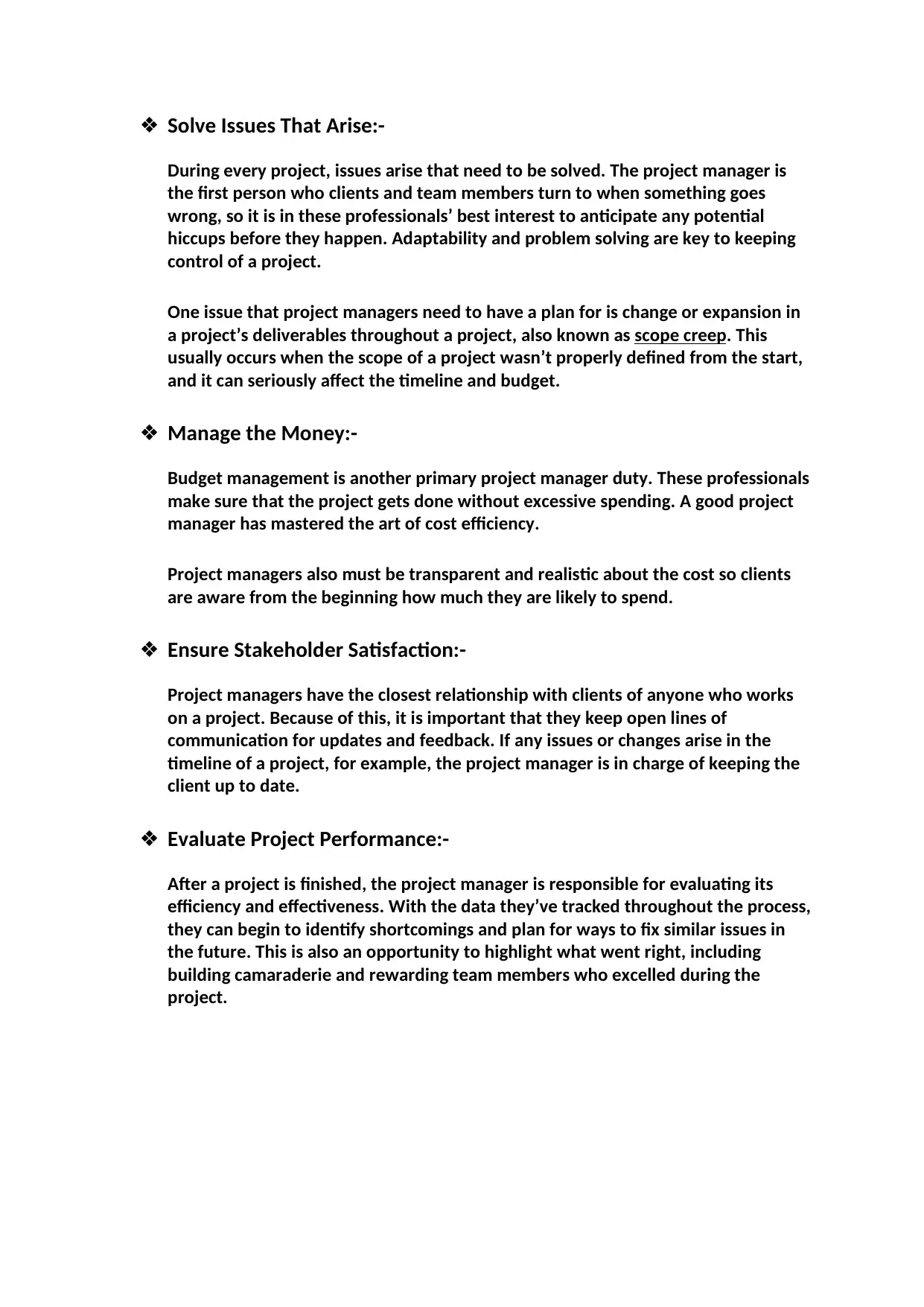
❖ Solve Issues That Arise:-
During every project, issues arise that need to be solved. The project manager is
the first person who clients and team members turn to when something goes
wrong, so it is in these professionals’ best interest to anticipate any potential
hiccups before they happen. Adaptability and problem solving are key to keeping
control of a project.
One issue that project managers need to have a plan for is change or expansion in
a project’s deliverables throughout a project, also known as scope creep. This
usually occurs when the scope of a project wasn’t properly defined from the start,
and it can seriously affect the timeline and budget.
❖ Manage the Money:-
Budget management is another primary project manager duty. These professionals
make sure that the project gets done without excessive spending. A good project
manager has mastered the art of cost efficiency.
Project managers also must be transparent and realistic about the cost so clients
are aware from the beginning how much they are likely to spend.
❖ Ensure Stakeholder Satisfaction:-
Project managers have the closest relationship with clients of anyone who works
on a project. Because of this, it is important that they keep open lines of
communication for updates and feedback. If any issues or changes arise in the
timeline of a project, for example, the project manager is in charge of keeping the
client up to date.
❖ Evaluate Project Performance:-
After a project is finished, the project manager is responsible for evaluating its
efficiency and effectiveness. With the data they’ve tracked throughout the process,
they can begin to identify shortcomings and plan for ways to fix similar issues in
the future. This is also an opportunity to highlight what went right, including
building camaraderie and rewarding team members who excelled during the
project.
During every project, issues arise that need to be solved. The project manager is
the first person who clients and team members turn to when something goes
wrong, so it is in these professionals’ best interest to anticipate any potential
hiccups before they happen. Adaptability and problem solving are key to keeping
control of a project.
One issue that project managers need to have a plan for is change or expansion in
a project’s deliverables throughout a project, also known as scope creep. This
usually occurs when the scope of a project wasn’t properly defined from the start,
and it can seriously affect the timeline and budget.
❖ Manage the Money:-
Budget management is another primary project manager duty. These professionals
make sure that the project gets done without excessive spending. A good project
manager has mastered the art of cost efficiency.
Project managers also must be transparent and realistic about the cost so clients
are aware from the beginning how much they are likely to spend.
❖ Ensure Stakeholder Satisfaction:-
Project managers have the closest relationship with clients of anyone who works
on a project. Because of this, it is important that they keep open lines of
communication for updates and feedback. If any issues or changes arise in the
timeline of a project, for example, the project manager is in charge of keeping the
client up to date.
❖ Evaluate Project Performance:-
After a project is finished, the project manager is responsible for evaluating its
efficiency and effectiveness. With the data they’ve tracked throughout the process,
they can begin to identify shortcomings and plan for ways to fix similar issues in
the future. This is also an opportunity to highlight what went right, including
building camaraderie and rewarding team members who excelled during the
project.
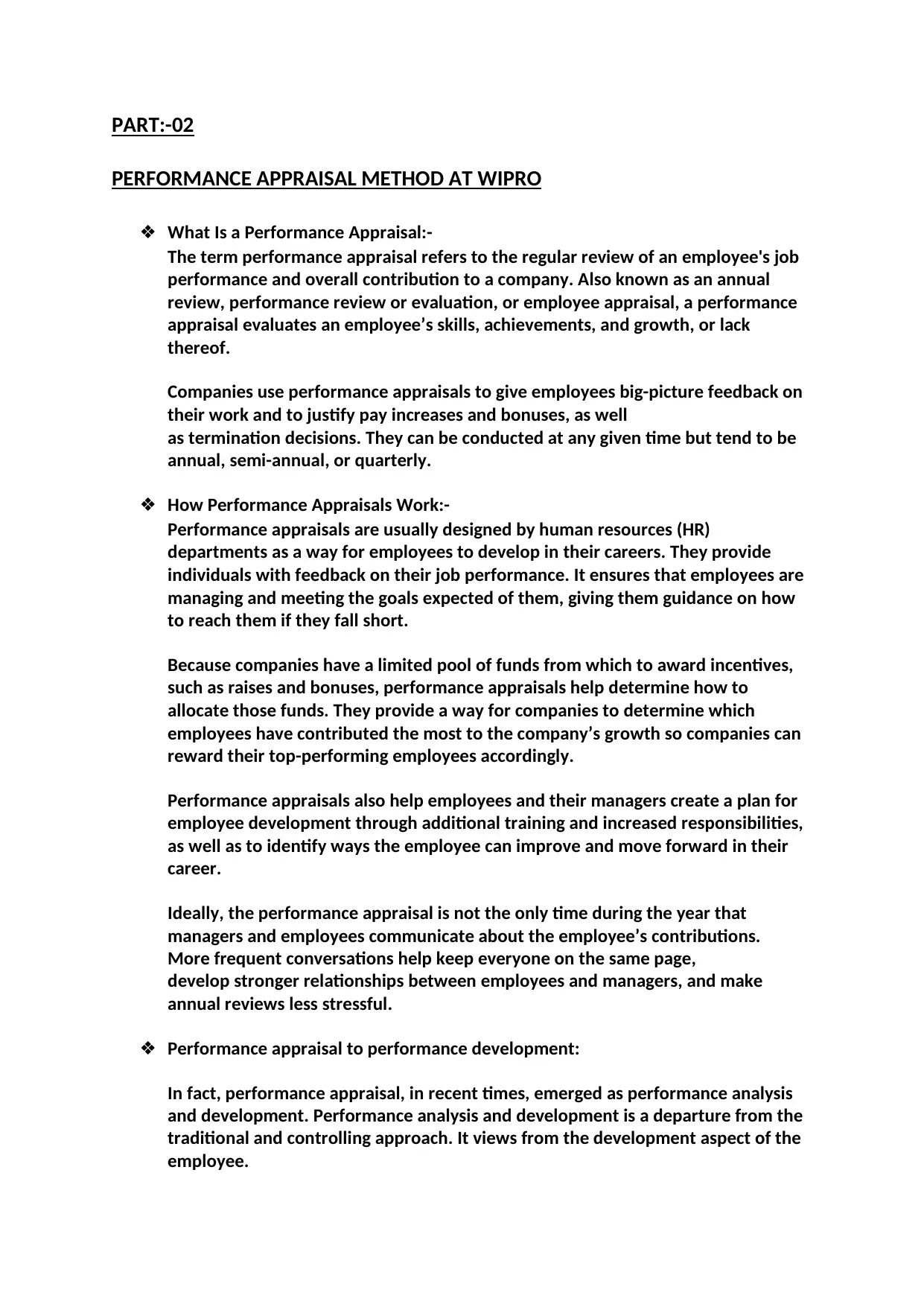
PART:-02
PERFORMANCE APPRAISAL METHOD AT WIPRO
❖ What Is a Performance Appraisal:-
The term performance appraisal refers to the regular review of an employee's job
performance and overall contribution to a company. Also known as an annual
review, performance review or evaluation, or employee appraisal, a performance
appraisal evaluates an employee’s skills, achievements, and growth, or lack
thereof.
Companies use performance appraisals to give employees big-picture feedback on
their work and to justify pay increases and bonuses, as well
as termination decisions. They can be conducted at any given time but tend to be
annual, semi-annual, or quarterly.
❖ How Performance Appraisals Work:-
Performance appraisals are usually designed by human resources (HR)
departments as a way for employees to develop in their careers. They provide
individuals with feedback on their job performance. It ensures that employees are
managing and meeting the goals expected of them, giving them guidance on how
to reach them if they fall short.
Because companies have a limited pool of funds from which to award incentives,
such as raises and bonuses, performance appraisals help determine how to
allocate those funds. They provide a way for companies to determine which
employees have contributed the most to the company’s growth so companies can
reward their top-performing employees accordingly.
Performance appraisals also help employees and their managers create a plan for
employee development through additional training and increased responsibilities,
as well as to identify ways the employee can improve and move forward in their
career.
Ideally, the performance appraisal is not the only time during the year that
managers and employees communicate about the employee’s contributions.
More frequent conversations help keep everyone on the same page,
develop stronger relationships between employees and managers, and make
annual reviews less stressful.
❖ Performance appraisal to performance development:
In fact, performance appraisal, in recent times, emerged as performance analysis
and development. Performance analysis and development is a departure from the
traditional and controlling approach. It views from the development aspect of the
employee.
PERFORMANCE APPRAISAL METHOD AT WIPRO
❖ What Is a Performance Appraisal:-
The term performance appraisal refers to the regular review of an employee's job
performance and overall contribution to a company. Also known as an annual
review, performance review or evaluation, or employee appraisal, a performance
appraisal evaluates an employee’s skills, achievements, and growth, or lack
thereof.
Companies use performance appraisals to give employees big-picture feedback on
their work and to justify pay increases and bonuses, as well
as termination decisions. They can be conducted at any given time but tend to be
annual, semi-annual, or quarterly.
❖ How Performance Appraisals Work:-
Performance appraisals are usually designed by human resources (HR)
departments as a way for employees to develop in their careers. They provide
individuals with feedback on their job performance. It ensures that employees are
managing and meeting the goals expected of them, giving them guidance on how
to reach them if they fall short.
Because companies have a limited pool of funds from which to award incentives,
such as raises and bonuses, performance appraisals help determine how to
allocate those funds. They provide a way for companies to determine which
employees have contributed the most to the company’s growth so companies can
reward their top-performing employees accordingly.
Performance appraisals also help employees and their managers create a plan for
employee development through additional training and increased responsibilities,
as well as to identify ways the employee can improve and move forward in their
career.
Ideally, the performance appraisal is not the only time during the year that
managers and employees communicate about the employee’s contributions.
More frequent conversations help keep everyone on the same page,
develop stronger relationships between employees and managers, and make
annual reviews less stressful.
❖ Performance appraisal to performance development:
In fact, performance appraisal, in recent times, emerged as performance analysis
and development. Performance analysis and development is a departure from the
traditional and controlling approach. It views from the development aspect of the
employee.
⊘ This is a preview!⊘
Do you want full access?
Subscribe today to unlock all pages.

Trusted by 1+ million students worldwide
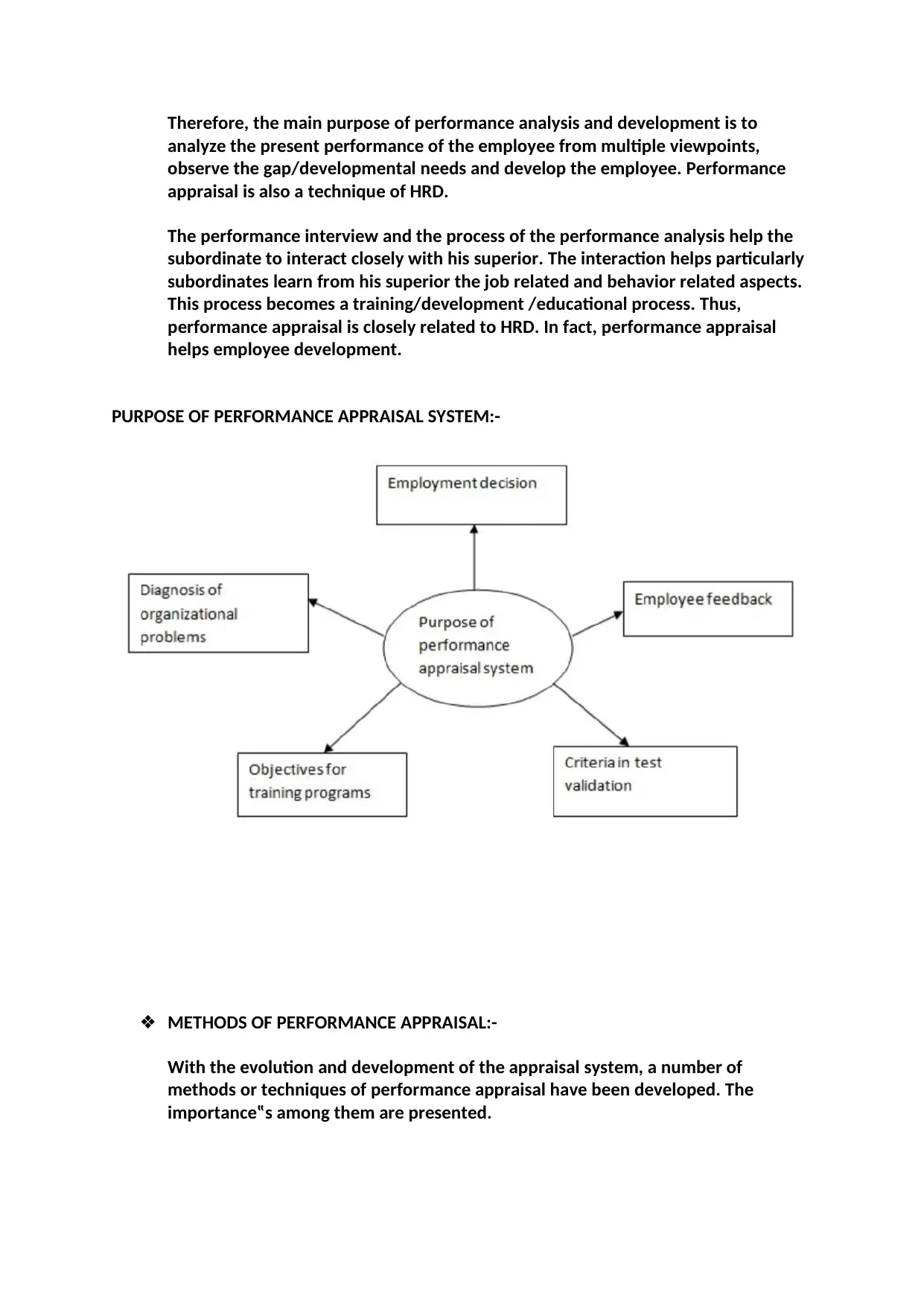
Therefore, the main purpose of performance analysis and development is to
analyze the present performance of the employee from multiple viewpoints,
observe the gap/developmental needs and develop the employee. Performance
appraisal is also a technique of HRD.
The performance interview and the process of the performance analysis help the
subordinate to interact closely with his superior. The interaction helps particularly
subordinates learn from his superior the job related and behavior related aspects.
This process becomes a training/development /educational process. Thus,
performance appraisal is closely related to HRD. In fact, performance appraisal
helps employee development.
PURPOSE OF PERFORMANCE APPRAISAL SYSTEM:-
❖ METHODS OF PERFORMANCE APPRAISAL:-
With the evolution and development of the appraisal system, a number of
methods or techniques of performance appraisal have been developed. The
importance‟s among them are presented.
analyze the present performance of the employee from multiple viewpoints,
observe the gap/developmental needs and develop the employee. Performance
appraisal is also a technique of HRD.
The performance interview and the process of the performance analysis help the
subordinate to interact closely with his superior. The interaction helps particularly
subordinates learn from his superior the job related and behavior related aspects.
This process becomes a training/development /educational process. Thus,
performance appraisal is closely related to HRD. In fact, performance appraisal
helps employee development.
PURPOSE OF PERFORMANCE APPRAISAL SYSTEM:-
❖ METHODS OF PERFORMANCE APPRAISAL:-
With the evolution and development of the appraisal system, a number of
methods or techniques of performance appraisal have been developed. The
importance‟s among them are presented.
Paraphrase This Document
Need a fresh take? Get an instant paraphrase of this document with our AI Paraphraser
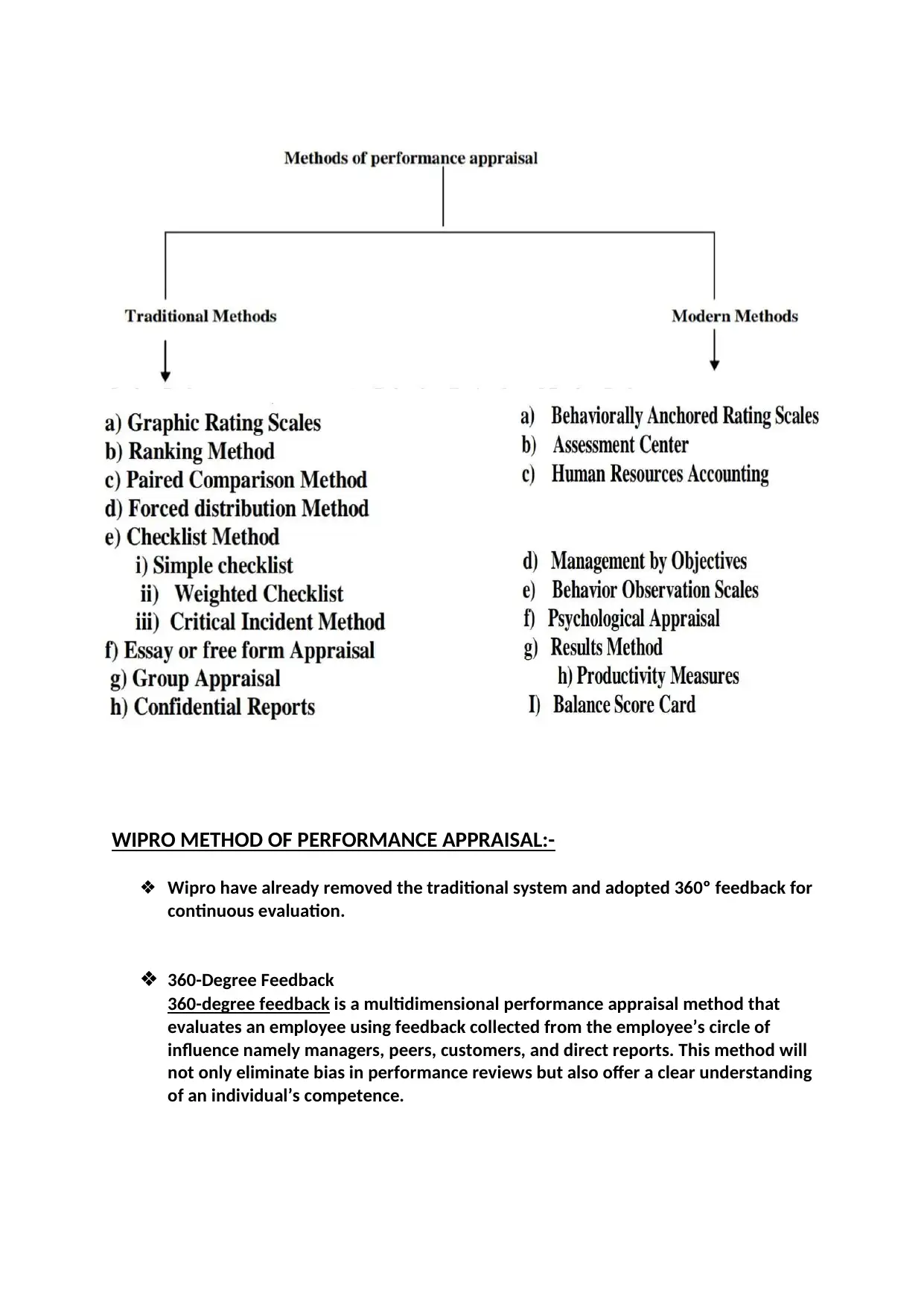
WIPRO METHOD OF PERFORMANCE APPRAISAL:-
❖ Wipro have already removed the traditional system and adopted 360º feedback for
continuous evaluation.
❖ 360-Degree Feedback
360-degree feedback is a multidimensional performance appraisal method that
evaluates an employee using feedback collected from the employee’s circle of
influence namely managers, peers, customers, and direct reports. This method will
not only eliminate bias in performance reviews but also offer a clear understanding
of an individual’s competence.
❖ Wipro have already removed the traditional system and adopted 360º feedback for
continuous evaluation.
❖ 360-Degree Feedback
360-degree feedback is a multidimensional performance appraisal method that
evaluates an employee using feedback collected from the employee’s circle of
influence namely managers, peers, customers, and direct reports. This method will
not only eliminate bias in performance reviews but also offer a clear understanding
of an individual’s competence.
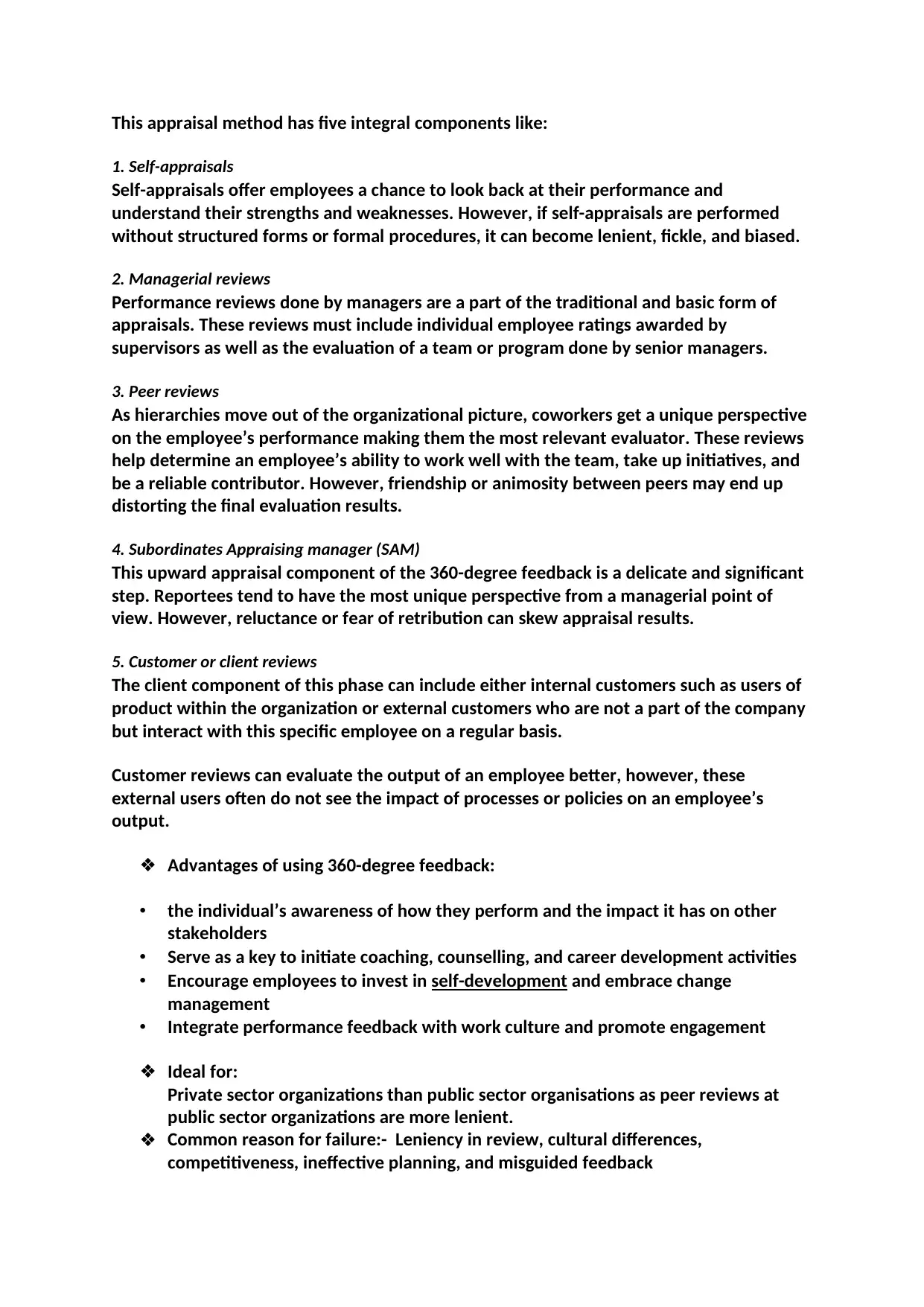
This appraisal method has five integral components like:
1. Self-appraisals
Self-appraisals offer employees a chance to look back at their performance and
understand their strengths and weaknesses. However, if self-appraisals are performed
without structured forms or formal procedures, it can become lenient, fickle, and biased.
2. Managerial reviews
Performance reviews done by managers are a part of the traditional and basic form of
appraisals. These reviews must include individual employee ratings awarded by
supervisors as well as the evaluation of a team or program done by senior managers.
3. Peer reviews
As hierarchies move out of the organizational picture, coworkers get a unique perspective
on the employee’s performance making them the most relevant evaluator. These reviews
help determine an employee’s ability to work well with the team, take up initiatives, and
be a reliable contributor. However, friendship or animosity between peers may end up
distorting the final evaluation results.
4. Subordinates Appraising manager (SAM)
This upward appraisal component of the 360-degree feedback is a delicate and significant
step. Reportees tend to have the most unique perspective from a managerial point of
view. However, reluctance or fear of retribution can skew appraisal results.
5. Customer or client reviews
The client component of this phase can include either internal customers such as users of
product within the organization or external customers who are not a part of the company
but interact with this specific employee on a regular basis.
Customer reviews can evaluate the output of an employee better, however, these
external users often do not see the impact of processes or policies on an employee’s
output.
❖ Advantages of using 360-degree feedback:
• the individual’s awareness of how they perform and the impact it has on other
stakeholders
• Serve as a key to initiate coaching, counselling, and career development activities
• Encourage employees to invest in self-development and embrace change
management
• Integrate performance feedback with work culture and promote engagement
❖ Ideal for:
Private sector organizations than public sector organisations as peer reviews at
public sector organizations are more lenient.
❖ Common reason for failure:- Leniency in review, cultural differences,
competitiveness, ineffective planning, and misguided feedback
1. Self-appraisals
Self-appraisals offer employees a chance to look back at their performance and
understand their strengths and weaknesses. However, if self-appraisals are performed
without structured forms or formal procedures, it can become lenient, fickle, and biased.
2. Managerial reviews
Performance reviews done by managers are a part of the traditional and basic form of
appraisals. These reviews must include individual employee ratings awarded by
supervisors as well as the evaluation of a team or program done by senior managers.
3. Peer reviews
As hierarchies move out of the organizational picture, coworkers get a unique perspective
on the employee’s performance making them the most relevant evaluator. These reviews
help determine an employee’s ability to work well with the team, take up initiatives, and
be a reliable contributor. However, friendship or animosity between peers may end up
distorting the final evaluation results.
4. Subordinates Appraising manager (SAM)
This upward appraisal component of the 360-degree feedback is a delicate and significant
step. Reportees tend to have the most unique perspective from a managerial point of
view. However, reluctance or fear of retribution can skew appraisal results.
5. Customer or client reviews
The client component of this phase can include either internal customers such as users of
product within the organization or external customers who are not a part of the company
but interact with this specific employee on a regular basis.
Customer reviews can evaluate the output of an employee better, however, these
external users often do not see the impact of processes or policies on an employee’s
output.
❖ Advantages of using 360-degree feedback:
• the individual’s awareness of how they perform and the impact it has on other
stakeholders
• Serve as a key to initiate coaching, counselling, and career development activities
• Encourage employees to invest in self-development and embrace change
management
• Integrate performance feedback with work culture and promote engagement
❖ Ideal for:
Private sector organizations than public sector organisations as peer reviews at
public sector organizations are more lenient.
❖ Common reason for failure:- Leniency in review, cultural differences,
competitiveness, ineffective planning, and misguided feedback
⊘ This is a preview!⊘
Do you want full access?
Subscribe today to unlock all pages.

Trusted by 1+ million students worldwide
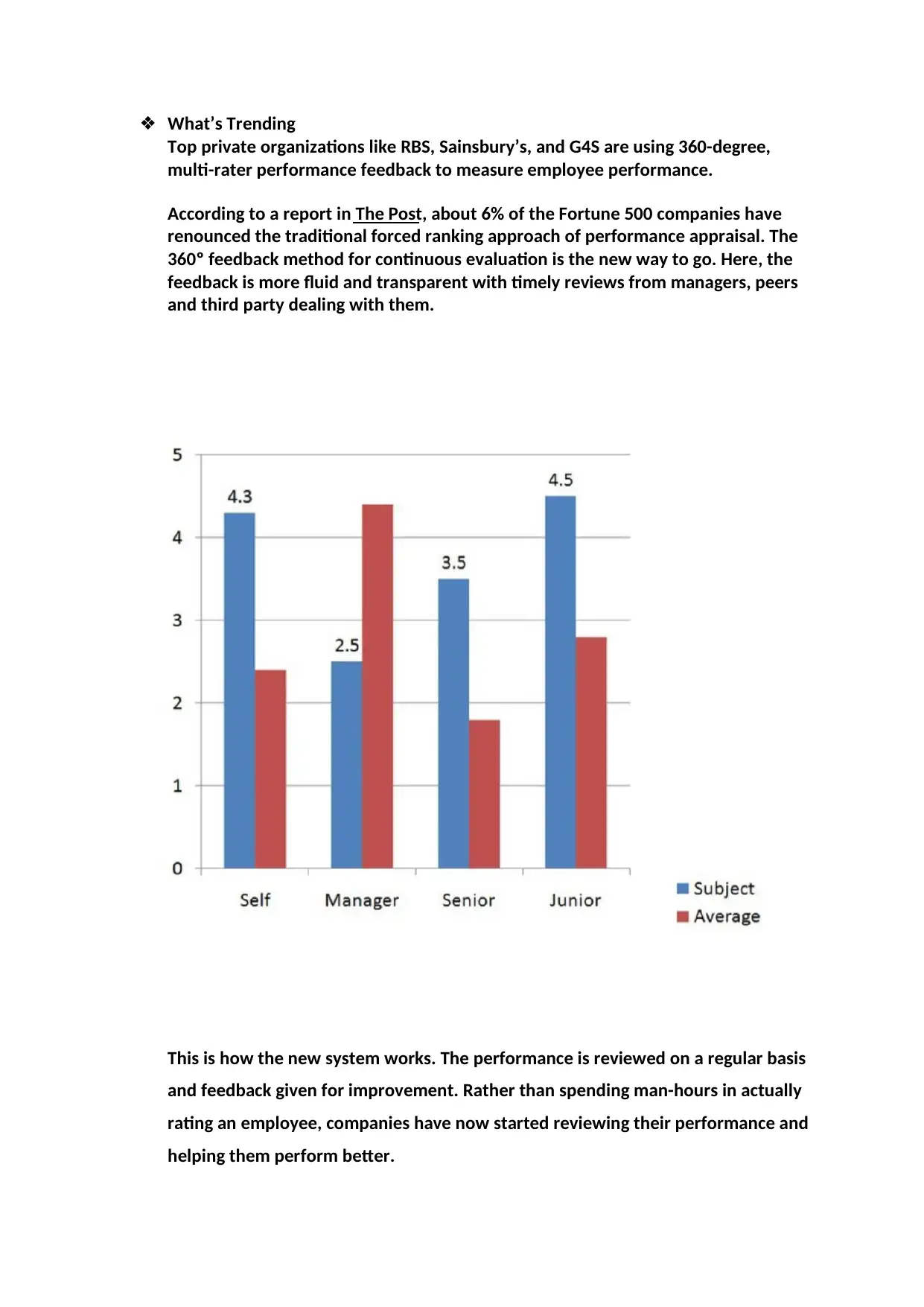
❖ What’s Trending
Top private organizations like RBS, Sainsbury’s, and G4S are using 360-degree,
multi-rater performance feedback to measure employee performance.
According to a report in The Post, about 6% of the Fortune 500 companies have
renounced the traditional forced ranking approach of performance appraisal. The
360º feedback method for continuous evaluation is the new way to go. Here, the
feedback is more fluid and transparent with timely reviews from managers, peers
and third party dealing with them.
This is how the new system works. The performance is reviewed on a regular basis
and feedback given for improvement. Rather than spending man-hours in actually
rating an employee, companies have now started reviewing their performance and
helping them perform better.
Top private organizations like RBS, Sainsbury’s, and G4S are using 360-degree,
multi-rater performance feedback to measure employee performance.
According to a report in The Post, about 6% of the Fortune 500 companies have
renounced the traditional forced ranking approach of performance appraisal. The
360º feedback method for continuous evaluation is the new way to go. Here, the
feedback is more fluid and transparent with timely reviews from managers, peers
and third party dealing with them.
This is how the new system works. The performance is reviewed on a regular basis
and feedback given for improvement. Rather than spending man-hours in actually
rating an employee, companies have now started reviewing their performance and
helping them perform better.
Paraphrase This Document
Need a fresh take? Get an instant paraphrase of this document with our AI Paraphraser
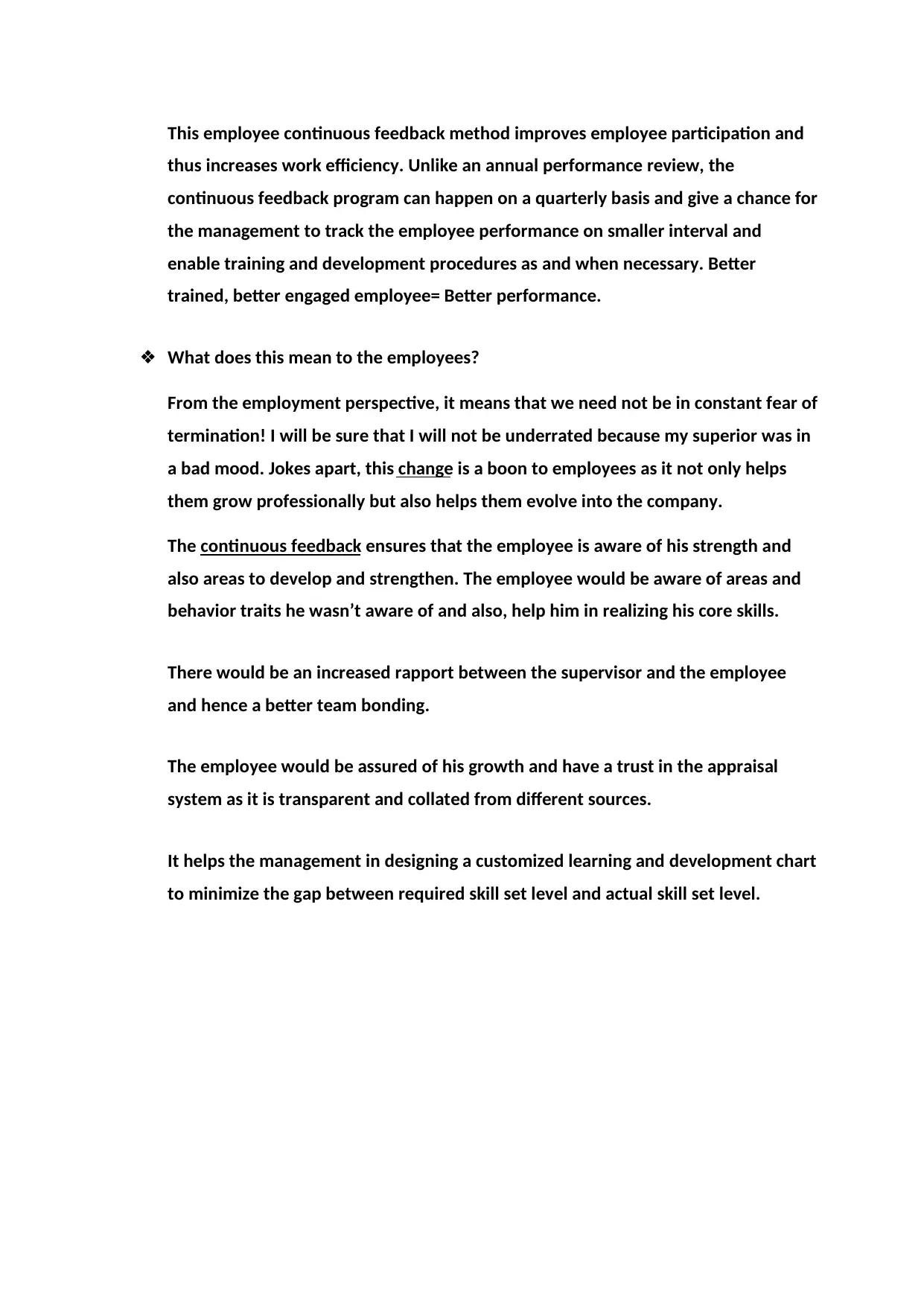
This employee continuous feedback method improves employee participation and
thus increases work efficiency. Unlike an annual performance review, the
continuous feedback program can happen on a quarterly basis and give a chance for
the management to track the employee performance on smaller interval and
enable training and development procedures as and when necessary. Better
trained, better engaged employee= Better performance.
❖ What does this mean to the employees?
From the employment perspective, it means that we need not be in constant fear of
termination! I will be sure that I will not be underrated because my superior was in
a bad mood. Jokes apart, this change is a boon to employees as it not only helps
them grow professionally but also helps them evolve into the company.
The continuous feedback ensures that the employee is aware of his strength and
also areas to develop and strengthen. The employee would be aware of areas and
behavior traits he wasn’t aware of and also, help him in realizing his core skills.
There would be an increased rapport between the supervisor and the employee
and hence a better team bonding.
The employee would be assured of his growth and have a trust in the appraisal
system as it is transparent and collated from different sources.
It helps the management in designing a customized learning and development chart
to minimize the gap between required skill set level and actual skill set level.
thus increases work efficiency. Unlike an annual performance review, the
continuous feedback program can happen on a quarterly basis and give a chance for
the management to track the employee performance on smaller interval and
enable training and development procedures as and when necessary. Better
trained, better engaged employee= Better performance.
❖ What does this mean to the employees?
From the employment perspective, it means that we need not be in constant fear of
termination! I will be sure that I will not be underrated because my superior was in
a bad mood. Jokes apart, this change is a boon to employees as it not only helps
them grow professionally but also helps them evolve into the company.
The continuous feedback ensures that the employee is aware of his strength and
also areas to develop and strengthen. The employee would be aware of areas and
behavior traits he wasn’t aware of and also, help him in realizing his core skills.
There would be an increased rapport between the supervisor and the employee
and hence a better team bonding.
The employee would be assured of his growth and have a trust in the appraisal
system as it is transparent and collated from different sources.
It helps the management in designing a customized learning and development chart
to minimize the gap between required skill set level and actual skill set level.
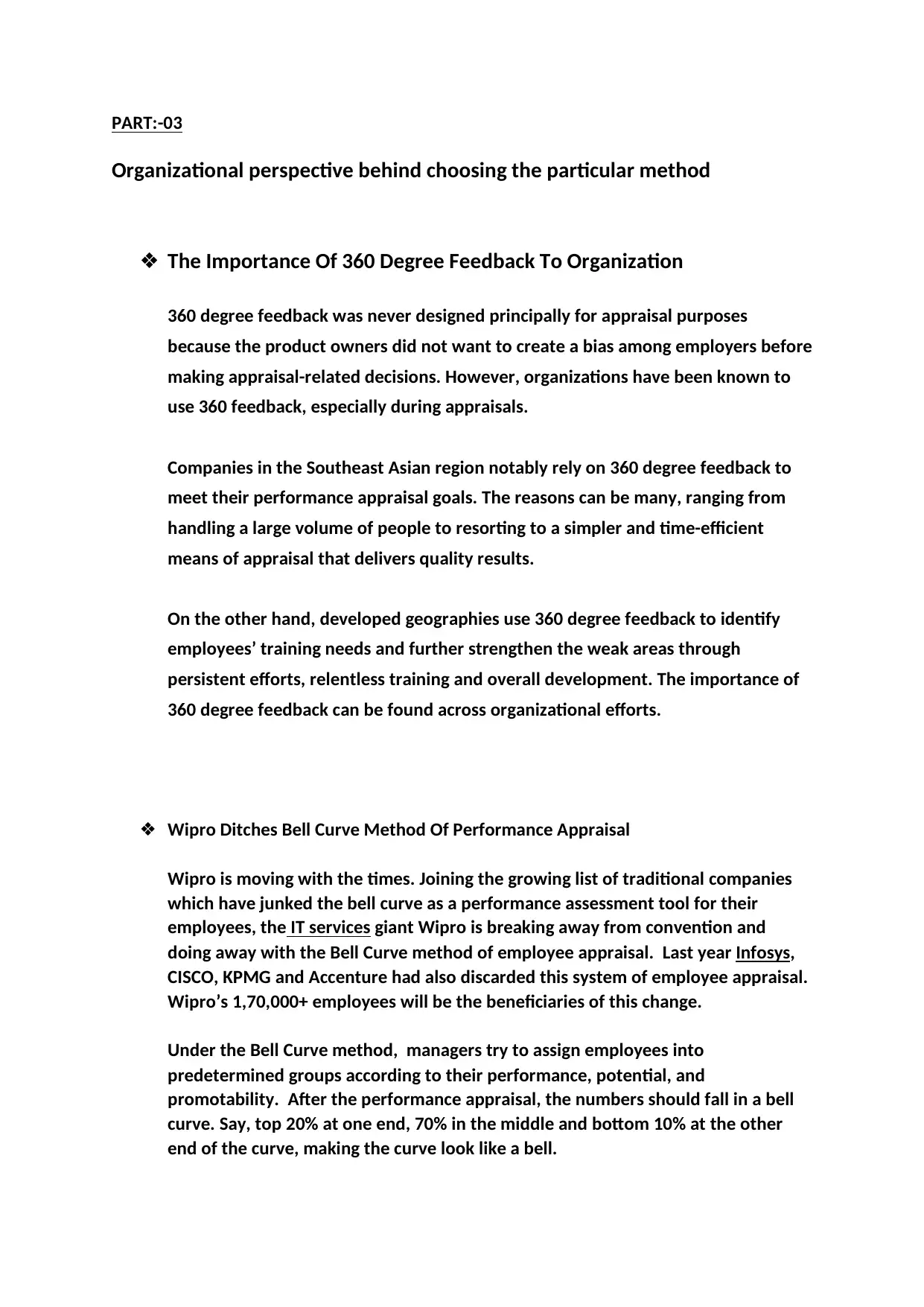
PART:-03
Organizational perspective behind choosing the particular method
❖ The Importance Of 360 Degree Feedback To Organization
360 degree feedback was never designed principally for appraisal purposes
because the product owners did not want to create a bias among employers before
making appraisal-related decisions. However, organizations have been known to
use 360 feedback, especially during appraisals.
Companies in the Southeast Asian region notably rely on 360 degree feedback to
meet their performance appraisal goals. The reasons can be many, ranging from
handling a large volume of people to resorting to a simpler and time-efficient
means of appraisal that delivers quality results.
On the other hand, developed geographies use 360 degree feedback to identify
employees’ training needs and further strengthen the weak areas through
persistent efforts, relentless training and overall development. The importance of
360 degree feedback can be found across organizational efforts.
❖ Wipro Ditches Bell Curve Method Of Performance Appraisal
Wipro is moving with the times. Joining the growing list of traditional companies
which have junked the bell curve as a performance assessment tool for their
employees, the IT services giant Wipro is breaking away from convention and
doing away with the Bell Curve method of employee appraisal. Last year Infosys,
CISCO, KPMG and Accenture had also discarded this system of employee appraisal.
Wipro’s 1,70,000+ employees will be the beneficiaries of this change.
Under the Bell Curve method, managers try to assign employees into
predetermined groups according to their performance, potential, and
promotability. After the performance appraisal, the numbers should fall in a bell
curve. Say, top 20% at one end, 70% in the middle and bottom 10% at the other
end of the curve, making the curve look like a bell.
Organizational perspective behind choosing the particular method
❖ The Importance Of 360 Degree Feedback To Organization
360 degree feedback was never designed principally for appraisal purposes
because the product owners did not want to create a bias among employers before
making appraisal-related decisions. However, organizations have been known to
use 360 feedback, especially during appraisals.
Companies in the Southeast Asian region notably rely on 360 degree feedback to
meet their performance appraisal goals. The reasons can be many, ranging from
handling a large volume of people to resorting to a simpler and time-efficient
means of appraisal that delivers quality results.
On the other hand, developed geographies use 360 degree feedback to identify
employees’ training needs and further strengthen the weak areas through
persistent efforts, relentless training and overall development. The importance of
360 degree feedback can be found across organizational efforts.
❖ Wipro Ditches Bell Curve Method Of Performance Appraisal
Wipro is moving with the times. Joining the growing list of traditional companies
which have junked the bell curve as a performance assessment tool for their
employees, the IT services giant Wipro is breaking away from convention and
doing away with the Bell Curve method of employee appraisal. Last year Infosys,
CISCO, KPMG and Accenture had also discarded this system of employee appraisal.
Wipro’s 1,70,000+ employees will be the beneficiaries of this change.
Under the Bell Curve method, managers try to assign employees into
predetermined groups according to their performance, potential, and
promotability. After the performance appraisal, the numbers should fall in a bell
curve. Say, top 20% at one end, 70% in the middle and bottom 10% at the other
end of the curve, making the curve look like a bell.
⊘ This is a preview!⊘
Do you want full access?
Subscribe today to unlock all pages.

Trusted by 1+ million students worldwide
1 out of 15
Your All-in-One AI-Powered Toolkit for Academic Success.
+13062052269
info@desklib.com
Available 24*7 on WhatsApp / Email
![[object Object]](/_next/static/media/star-bottom.7253800d.svg)
Unlock your academic potential
Copyright © 2020–2025 A2Z Services. All Rights Reserved. Developed and managed by ZUCOL.